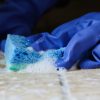- Empty cart.
- Continue Shopping
How Should I Wash Vegetables?

Fresh vegetables are an important component of a healthy diet, whether you are preparing a gourmet meal or just throwing together a quick salad. But before you bite into that crunchy carrot or crisp cucumber, there is one crucial step you should never skip: washing your vegetables properly.
In this detailed guide, we’ll walk you through why vegetable washing is important, how to do it the right way, tips for washing different types of vegetables, and how products like vegetable wash 500ml and vegetable wash 1ltr can make the process even safer and more effective.
Why Washing Vegetables Matters
You might think that rinsing your veggies under tap water is enough—but think again.
Vegetables can harbor:
- Dirt and soil particles
- Pesticide residues
- Harmful bacteria like E. coli and Salmonella
- Waxes and preservatives
- Chemical contaminants from transport and storage
If you do not wash your vegetables correctly, doing so can lead to serious health problems, particularly in children, pregnant women, and people with weakened immune systems. This is why it is more important than ever to learn the proper way to wash vegetables.
Step-by-Step: How to Wash Vegetables Properly
Here’s a simple but effective method to ensure your vegetables are safe to eat.
Step 1: Wash Your Hands
Wash your hands well with soap and warm water for at least 20 seconds before touching any produce. This is important to ensure that no germs from your skin are transferred to the food.
Step 2: Clean Your Work Area
Make sure your sink, cutting board, and countertop are cleaned and sanitized. Bacteria can remain on these surfaces and easily be transferred to fresh produce.
Step 3: Rinse with Running Water
Holding your vegetables in clean, cold running water, rinse them well. Do not use hot water; it could wilt some produce and allow bacteria to enter and be absorbed by vegetables.
Step 4: Use a Scrubbing Brush or Your Hands
For firm vegetables, such as potatoes, carrots, and cucumbers, use a clean provided brush to scrub dirt off before rinsing with water. Alternatively, leafy greens and other soft vegetables should be gently rubbed with your hands.
Step 5: Soak When Needed
Certain vegetables—including leafy greens—really benefit from a quick soak in clean water for a few minutes. Adding a splash of vinegar or a food-safe produce cleaner can enhance this process.
Why Plain Water Might Not Be Enough
Water is great, but water alone will sometimes fail to remove pesticide residues, synthetic waxes, and microbial contaminants on the surface of vegetables. Cleaner solutions specifically for vegetables fill this gap.
A reputable food-safe cleaner for vegetables, like vegetable wash 500 mL, is capable of removing up to 99.9% of contaminants on the surface of vegetables while maintaining the freshness and texture of the vegetables you buy.
How to Use a Vegetable Wash (The Right Way)
Let’s take a closer look at how to use products like vegetable wash 500ml to maximize your cleaning routine:
- Prepare a Solution: Pour the recommended amount (usually a capful) of vegetable wash into a bowl of clean water that is large enough for the vegetables you are cleaning.
- Soak the Produce: Submerge your vegetables in the vegetable wash for 2-5 minutes.
- Gently Agitate: Using your hands, gently swish the vegetables around in the vegetable wash to help remove contaminants.
- Rinse Well: After soaking, rinse all vegetables well under running water to remove food-safe vegetable cleaner and contaminants.
- Dry Before Storing: Pat all vegetables dry with a clean kitchen towel or paper towel before storing or using.
Not only will it remove “surface grime,” it will also save the life of your veggies in the storage process by reducing microbial growth on the surface.
How to Wash Different Types of Vegetables
Different types of vegetables require slightly different cleaning methods. Let’s break it down by category.
- Leafy Greens (Spinach, Lettuce, Kale)
- Remove outer leaves and discard any wilted ones.
- Soak in cold water for 5–10 minutes.
- Rinse thoroughly under running water.
- Use a salad spinner or pat dry.
- Root Vegetables (Potatoes, Carrots, Beets)
- Scrub with a stiff-bristled brush.
- Rinse thoroughly to remove all dirt.
- Peel if needed, but remember many nutrients are in the skin.
- Cruciferous Veggies (Broccoli, Cauliflower, Cabbage)
- Separate into smaller pieces or florets.
- Soak in a bowl with a bit of salt or vinegar to remove insects and debris.
- Rinse well and dry completely.
- Soft Vegetables (Tomatoes, Peppers, Eggplant)
- Avoid using a brush—these bruise easily.
- Rinse under cool water, rubbing gently with your hands.
- Dry gently with a paper towel.
Where to Find Large Quantity Washes
For those who prepare large family meals or bulk prep food for the week, buying a more considerable amount will likely be beneficial for your family and your budget.
A great solution is vegetable wash 1ltr, which is perfect for households or small food businesses that need a cost-effective and efficient cleaning method without compromising on safety.
This larger quantity ensures that you’re never out of cleaning solution when you need it the most. Plus, it saves money in the long run.
Common Myths About Washing Vegetables
Let’s bust some myths and misconceptions.
Myth #1: Organic Vegetables Don’t Need to Be Washed
Truth: While organic produce is free from synthetic pesticide residues, it is still subject to the presence of bacteria, dirt, and other contaminants.
Myth #2: Boiling or Cooking Kills Everything
Truth: Boiling can destroy some types of bacteria, but as noted above, anything that remains on the surface of your food (such as wax or surface pesticide residue) will remain unless removed prior to cooking.
Myth #3: Washing Before Storing is Better
Truth: It is also worth mentioning that washing produce prior to storage can actually result in it spoiling sooner, so vegetables should be washed immediately prior to use, unless they have been dried completely.
Benefits of Using Vegetable Wash 500ml
Still wondering if it’s worth switching to a dedicated cleaner? Here’s a more detailed look at the benefits:
- Removes harmful chemicals without damaging produce.
Our special vegetable wash 500ml is different in that it is PH balanced to remove pesticide residue dirt, and chemical coatings that neither washing with plain water or boiling will remove safely, while maintaining the natural beneficial nutrients that are present on the surface of the product.
- Non-toxic and food safe, even for kids and the elderly.
Our formula is 100% non-toxic and only made with food-grade ingredients, which means it is completely safe for everyone to use at every age — even when preparing baby food or for older adults.
- Prevents bacterial infections by eliminating hidden pathogens.
Harmful bacteria, such as E. coli and Salmonella, are likely present in the crevices of fruits and vegetables, as well as the leaves themselves. Using a specialized vegetable wash 500ml will help eliminate these bacteria, thus decreasing the risk of foodborne illnesses.
- Preserves natural freshness, texture, and flavor.
Vegetable wash 500ml is similar to other vegetable washes, except that it will not alter the taste or texture of your food. In fact, if you are conscious of waxes and chemical residues, it will improve the freshness of your food, and will taste just the way nature intended it.
- Works on all types of vegetables—leafy, firm, soft, and everything in between.
From delicate spinach to firm root vegetables, vegetable wash 500ml works on them all. It is a flexible way to streamline your cleaning routine without the different products.
Key Takeaways
Vegetables are among the healthiest foods we can eat, but only if they are free of dirt or hazardous residues. With the growing population of individuals who are aware of food safety and health consequences, there really is no excuse not to take this step.
Here’s what you should remember:
- Wash your hands, surfaces, and produce before every meal.
- Rinse thoroughly using proper methods for each vegetable type.
- Use food-safe solutions like vegetable wash 500ml to boost cleanliness.
- For heavy use, go for larger sizes like vegetable wash 1ltr to save time and cost.
With these measures, you’re not just making your food cleaner, you are also making it safer and healthier for everyone else around the table.
Conclusion
We are exposed to toxins and contaminants far too much in today’s world; taking control of your kitchen hygiene is one of the best things you can do. Cleaning your vegetables isn’t difficult, but it will take a little careful, consistent practice, and the right products.
Using vegetable wash 500ml in your cleaning regiment will give you the peace of mind that your food is safe to consume and is fresh. And when you have bigger needs, you’ll have vegetable wash 1ltr for your home, small business or larger enterprise.
Let’s make washing vegetables a higher priority – for your health, for those you care about, and your peace of mind.





